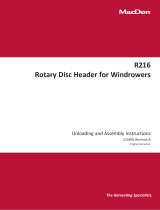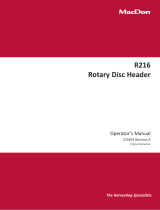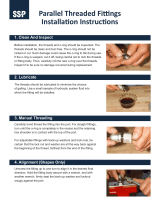Page is loading ...

R85
Rotary Disc 4.9-Meter (16-Foot)
Self-Propelled Windrower Header
Unload and Assembly Instructions
214367 Revision A
2018 Model Year
Original Instruction
The harvesting specialists.

R85 Rotary Disc 4.9-Meter (16-Foot) Self-Propelled Windrower Header
1005291
Published: August 2017

Introduction
This instructional manual describes the unloading, setup, and predelivery requirements for MacDon Model R85
Rotary Disc 4.9-Meter (16-Foot) Self-Propelled Windrower Headers.
Carefully read all the material provided before attempting to use or service the machine.
When setting up the machine or making adjustments, review and follow the recommended machine settings in all
relevant MacDon publications. Failure to do so may compromise machine function and machine life and may result
in a hazardous situation.
Conventions
The following conventions are used in this document:
• Right and left are determined from the operator’s position, facing forward with the windrower in cab-forward
position.
• Unless otherwise noted, use the standard torque values provided in Chapter 5 Reference, page 97 of this
document.
NOTE: Keep your MacDon publications up-to-date. The most current version can be downloaded from our website
(www.macdon.com) or from our Dealer-only site (https://portal.macdon.com) (login required).
214367 i Revision A

List of Revisions
The following list provides an account of major changes from the previous version of this document.
Summary of Changes
Location
Changed measurement format so that metric values
appear first followed by imperial in parentheses.
Throughout the book
Added conventions to Introduction. Introduction, page i
Added illustration, reorganized topic contents. 2 Unloading the Header, page 5
Updated illustration and adjusted callouts in steps. 3.4 Lowering Header, page 11
Updated illustration and figure title. 3.7 Unpacking Curtains, page 18
Added step, note, and illustration for installing M200
hose support on header.
3.9 Assembling Forming Shield, page 24
Added note to procedure.
3.10 Installing Forming Shield, page 28
Updated illustrations.
3.11.1 Attaching Header to an M200 or M205
Windrower: Hydraulic Center-Link with Optional
Self-Alignment, page 31
Updated illustrations.
3.11.2 Attaching Header to an M200 or M205
Windrower: Hydraulic Center-Link without Optional
Self-Alignment, page 36
Updated illustrations.
3.11.3 Attaching Header to an M200 Windrower:
Mechanical Center-Link, page 41
Updated topic description.
3.12 Attaching Header to an M1 Series Windrower,
page 45
Updated procedure steps and illustrations.
3.12.1 Attaching Header to an M1240 Windrower:
Hydraulic Center-Link with Optional Self-Alignment,
page 45
Updated illustration.
3.12.2 Attaching Header to an M1240 Windrower:
Hydraulic Center-Link without Optional Self-Alignment,
page 50
Added steps for connecting header to M205 windrower
using hard plumb connections.
3.13.1 Attaching Hydraulic and Electrical Components:
M205 Windrowers, page 56
Added note for removing electrical harness extension
from header before connecting to M205 windrower.
3.13.1 Attaching Hydraulic and Electrical Components:
M205 Windrowers, page 56
Updated steps and illustrations, clarified manifold port
IDs for hydraulic connections.
3.13.2 Attaching Hydraulic and Electrical Components:
M200 Windrowers, page 61
Updated procedure to include steps for connecting
header to M1240 windrower using quick-connect and
hard plumb fittings.
3.13.3 Attaching Hydraulics and Electrical: M1240
Windrowers, page 67
Added note at beginning of topic and added footnote
referring users to quick coupler kits available for M1240
windrowers configured for disc headers, and auger and
draper headers.
3.13.3 Attaching Hydraulics and Electrical: M1240
Windrowers, page 67
214367 ii Revision A

Summary of Changes
Location
Updated figure title/description. 3.14.5 Installing Tall Crop Feed Plates, page 74
Updated topic title.
4.2 Checking Header Float: M200 and M205
Windrowers, page 83
Added topic to manual.
4.3 Checking Header Float: M1240 Windrowers, page
84
Added topic to manual.
4.3.1 Setting the Float: M1240 Windrower, page 84
Updated procedure illustrations.
4.4 Checking Header Level, page 86
Added note and steps to procedure. Updated figure
title/description.
4.5.1 Checking Conditioner Roll Gap, page 88
Added hazard statement and steps.
4.5.2 Checking Conditioner Roll Timing, page 89
Reordered procedure steps.
4.8 Preparing the Conditioner Roll Timing Gearbox,
page 93
Updated illustration to show new light brackets and
added identifying callouts to procedure.
4.9 Checking Lights, page 94
214367 iii Revision A


214367 v Revision A
Introduction................................................................................................................................................i
List of Revisions ........................................................................................................................................ ii
Chapter 1: Safety .................................................................................................................................... 1
1.1 Signal Words .......................................................................................................................................1
1.2 General Safety.....................................................................................................................................2
1.3 Safety Signs ........................................................................................................................................4
Chapter 2: Unloading the Header ....................................................................................................... 5
Chapter 3: Assembling the Header .................................................................................................... 7
3.1 Removing Underside Shipping Support and Installing Auger Pan ............................................................ 7
3.2 Installing Skid Shoes (Optional) ............................................................................................................9
3.3 Installing Gauge Rollers (Optional) ......................................................................................................10
3.4 Lowering Header ............................................................................................................................... 11
3.5 Removing Shipping Stands.................................................................................................................13
3.6 Installing Swath Baffle Lever ..... ..........................................................................................................17
3.7 Unpacking Curtains............................................................................................................................18
3.8 Attaching Conditioner Cover ...............................................................................................................22
3.9 Assembling Forming Shield ................................................................................................................24
3.10 Installing Forming Shield...................................................................................................................28
3.11 Attaching Header to an M Series Windrower.......................................................................................31
3.11.1 Attaching Header to an M200 or M205 Windrower: Hydraulic Center-Link with Optional
Self-Alignment.................................................................................................................... 31
3.11.2 Attaching Header to an M200 or M205 Windrower: Hydraulic Center-Link without Optional
Self-Alignment.................................................................................................................... 36
3.11.3 Attaching Header to an M200 Windrower: Mechanical Center-Link .............................................. 41
3.12 Attaching Header to an M1 Series Windrower.....................................................................................45
3.12.1 Attaching Header to an M1240 Windrower: Hydraulic Center-Link with Optional Self-
Alignment...........................................................................................................................45
3.12.2 Attaching Header to an M1240 Windrower: Hydraulic Center-Link without Optional
Self-Alignment.................................................................................................................... 50
3.13 Attaching Hydraulics and Electrical Connections ................................................................................56
3.13.1 Attaching Hydraulic and Electrical Components: M205 Windrowers ............................................56
3.13.2 Attaching Hydraulic and Electrical Components: M200 Windrowers ............................................61
3.13.3 Attaching Hydraulics and Electrical: M1240 Windrowers.............................................................67
3.14 Installing Other Options ....................................................................................................................71
3.14.1 Installing Tall Crop Divider........................................................................................................71
3.14.2 Installing Double Windrow Attachment (DWA) ........................................................................... 72
3.14.3 Installing Skid Shoes (Optional)................................................................................................73
3.14.4 Installing Gauge Rollers (Optional) ........................................................................................... 73
3.14.5 Installing Tall Crop Feed Plates ................................................................................................74
TABLE OF CONTENTS

214367 vi Revision A
3.14.6 Installing Nut Protectors (for Blade Hardware on Discs)..............................................................74
3.15 Lubricating the Header .....................................................................................................................75
3.15.1 Driveshields ............................................................................................................................75
Opening the Driveshield: North American Headers...................................................................... 75
Closing the Driveshield: North American Headers .......................................................................75
Opening the Driveshield: Export Headers ...................................................................................76
Closing the Driveshield: Export Headers..................................................................................... 76
3.15.2 Greasing Procedure ................................................................................................................77
3.15.3 Lubrication Points....................................................................................................................77
Chapter 4: Performing Predelivery Checks ............................................ ....................................... 81
4.1 Checking Drive Belts ..........................................................................................................................81
4.2 Checking Header Float: M200 and M205 Windrowers...........................................................................83
4.3 Checking Header Float: M1240 Windrowers ........................................................................................84
4.3.1 Setting the Float: M1240 Windrower ...........................................................................................84
4.4 Checking Header Level ......................................................................................................................86
4.5 Checking Conditioner Rolls.................................................................................................................88
4.5.1 Checking Conditioner Roll Gap ..................................................................................................88
4.5.2 Checking Conditioner Roll Timing ............................................................................................... 89
4.6 Checking Gauge Rollers or Skid Shoes ...............................................................................................91
4.7 Preparing the Bevel Gearbox ..............................................................................................................92
4.8 Preparing the Conditioner Roll Timing Gearbox ....................................................................................93
4.9 Checking Lights .................................................................................................................................94
4.10 Checking Manuals............................................................................................................................95
4.11 Running up the Header.....................................................................................................................96
Chapter 5: Reference ........................................................................................................................... 97
5.1 Torque Specifications .........................................................................................................................97
5.1.1 SAE Bolt Torque Specifications ..................................................................................................97
5.1.2 Metric Bolt Specifications...........................................................................................................99
5.1.3 Metric Bolt Specifications Bolting into Cast Aluminum ................................................................101
5.1.4 Flare-Type Hydraulic Fittings.................................................................................................... 102
5.1.5 O-Ring Boss (ORB) Hydraulic Fittings (Adjustable) .... ................................................................103
5.1.6 O-Ring Boss (ORB) Hydraulic Fittings (Non-Adjustable)............................................................. 105
5.1.7 O-Ring Face Seal (ORFS) Hydraulic Fittings .............................................................................106
5.1.8 Tapered Pipe Thread Fittings ...................................................................................................107
5.2 Conversion Chart. ............................................................................................................................ 108
5.3 Definitions ....................................................................................................................................... 109
Predelivery Checklist......................................................................................................................... 1 1 1
TABLE OF CONTENTS

214367 1 Revision A
1 Safety
1.1 Signal Words
Three signal words, DANGER, WARNING, and CAUTION, are used to alert you to hazardous situations.
The appropriate signal word for each situation has been selected using the following guidelines:
DANGER
Indicates an imminently hazardous situation that, if not avoided, will result in death or serious injury.
WARNING
Indicates a potentially hazardous situation that, if not avoided, could result in death or serious injury.
It may also be used to alert against unsafe practices.
CAUTION
Indicates a potentially hazardous situation that, if not avoided, may result in minor or moderate injury.
It may be used to alert against unsafe practices.

214367 2 Revision A
1.2 General Safety
1000004
Figure 1.1: Safety Equipment
CAUTION
The following are general farm safety precautions that
should be part of your operating procedure for all types
of machinery.
Protect yourself.
• When assembling, operating, and servicing machinery,
wear all protective clothing and personal safety devices
that could be necessary for job at hand. Do NOT take
chances. You may need the following:
• Hard hat
• Protective footwear with slip resistant soles
• Protective glasses or goggles
• Heavy gloves
• Wet weather gear
• Respirator or filter mask
1000005
Figure 1.2: Safety Equipment
• Be aware that exposure to loud noises can cause hearing
impairment or loss. Wear suitable hearing protection
devices such as earmuffs or earplugs to help protect
against loud noises.
1010391
Figure 1.3: Safety Equipment
• Provide a first aid kit for use in case of emergencies.
• Keep a fire extinguisher on the machine. Be sure fire
extinguisher is properly maintained. Be familiar with its
proper use.
• Keep young children away from machinery at all times.
• Be aware that accidents often happen when Operator is
tired or in a hurry. Take time to consider safest way.
Never ignore warning signs of fatigue.
SAFETY

214367 3 Revision A
1000007
Figure 1.4: Safety around Equipment
• Wear close-fitting clothing and cover long hair. Never
wear dangling items such as scarves or bracelets.
• Keep all shields in place. NEVER alter or remove safety
equipment. Make sure driveline guards can rotate
independently of shaft and can telescope freely.
• Use only service and repair parts made or approved by
equipment manufacturer. Substituted parts may not meet
strength, design, or safety requirements.
1000008
Figure 1.5: Safety around Equipment
• Keep hands, feet, clothing, and hair away from moving
parts. NEVER attempt to clear obstructions or objects
from a machine while engine is running.
• Do NOT modify machine. Unauthorized modifications
may impair machine function and/or safety. It may also
shorten machine’s life.
• To avoid bodily injury or death from unexpected startup of
machine, ALWAYS stop the engine and remove the key
from the ignition before leaving the operator’s seat for
any reason.
1000009
Figure 1.6: Safety around Equipment
• Keep service area clean and dry. Wet or oily floors are
slippery. Wet spots can be dangerous when working with
electrical equipment. Be sure all electrical outlets and
tools are properly grounded.
• Keep work area well lit.
• Keep machinery clean. Straw and chaff on a hot engine is
a fire hazard. Do NOT allow oil or grease to accumulate
on service platforms, ladders, or controls. Clean
machines before storage.
• NEVER use gasoline, naphtha, or any volatile material for
cleaning purposes. These materials may be toxic and/or
flammable.
• When storing machinery, cover sharp or extending
components to prevent injury from accidental contact.
SAFETY

214367 4 Revision A
1.3 Safety Signs
1000694
Figure 1.7: Operator’s Manual Decal
• Keep safety signs clean and legible at all times.
• Replace safety signs that are missing or become illegible.
• If original parts on which a safety sign was installed are
replaced, be sure repair part also bears current
safety sign.
• Safety signs are available from your MacDon Dealer.
SAFETY

214367 5 Revision A
2 Unloading the Header
CAUTION
To avoid injury to bystanders from being struck by machinery, do NOT allow people to stand in
unloading area.
CAUTION
Equipment used for unloading must meet or exceed the requirements specified below. Using inadequate
equipment may result in chain breakage, vehicle tipping, or machine damage.
1013855
A
B
C
Figure 2.1: Minimum Lifting Capacity
A - Load Center of Gravity
B - Load Center 1220 mm (48 in.) from Back of Forks
C - Minimum Fork Length 1981 mm (78 in.)
IMPORTANT:
Forklifts are normally rated for a load located 610 mm
(24 in.) ahead of the back end of the forks. To obtain the
forklift capacity at 1220 mm (48 in.), check with your forklift
distributor.
Table 2.1 Lifting Vehicle
Minimum Capacity 3630 kg (8000 lb.)
Minimum Fork Length
198 cm (78 in.)
1009203
Figure 2.2: Lifting Header off Trailer
1. Remove hauler’s tie-down straps and chains.
WARNING
Be sure forks are secure before moving away from load.
Stand clear when lifting.
2. Approach header from its underside and slide forks in
under the lifting framework as far as possible.
IMPORTANT:
If load is two units wide, take care to avoid contacting
the other machine.
3. Raise header off the deck.

214367 6 Revision A
1009204
Figure 2.3: Moving Header with Forklift
4. Back up until the unit clears trailer, and slowly lower to
150 mm (6 in.) from the ground.
5. Take to storage or setup area.
6. Set machine down on secure, level ground.
7. If hydraulic motor and hoses are shipped separately on
pallet, unload pallet.
8. Check for shipping damage and missing parts.
UNLOADING THE HEADER

214367 7 Revision A
3 Assembling the Header
3.1 Removing Underside Shipping Support and Installing
Auger Pan
CAUTION
Keep feet clear when removing final bolts.
1009307
A
B
Figure 3.1: Shipping Support
1. Use a forklift to support stand.
2. Remove two bolts (A) on each end of support and
remove shipping support (B). Lay support on ground.
1009206
A
B
Figure 3.2: Auger Pan Attached to
Shipping Support
3. Cut banding (A), and remove auger pan (B) and
hardware from stand. Discard stand.
4. Locate the hardware bag strapped between auger
pan (B) and the stand.

214367 8 Revision A
1009346
A
A
B
C
D
Figure 3.3: Auger Pan Installed
5. Position auger pan (A) against cutterbar lugs and install
four 1/2 x 3.5 in. long bolts (B) and lock nuts. Do NOT
fully tighten.
6. Check and make sure that auger pan is oriented
as shown.
7. Check and make sure that center pan is position evenly
before tightening. Tighten enough so nut is locked and
pan can still pivot.
8. Retrieve plates (C) from hardware bag, and install as
shown at each end of pan with four 1/2 x 1.0 in.
bolts (D). Tighten hardware.
NOTE:
There may be a gap between the cutterbar lugs and the
auger pan when tightening the hardware. The hardware
does not need to pull the auger pan flush against the
cutterbar lugs.
ASSEMBLING THE HEADER

214367 9 Revision A
3.2 Installing Skid Shoes (Optional)
NOTE:
This kit may be installed later in the assembly sequence, but installation may be easier prior to laying the header
down.
DANGER
To avoid bodily injury or death from unexpected startup of the machine, always stop the engine and
remove the key from the ignition before leaving the operator’s seat for any reason.
1. Lower header to the ground, shut off engine, and remove key from ignition.
2. Unpack kit.
1009207
Figure 3.4: Skid Shoe (Right Side Shown – Left
Side Similar)
3. Install skid shoes. Refer to instruction supplied with kit.
ASSEMBLING THE HEADER

214367 10 Revision A
3.3 Installing Gauge Rollers (Optional)
NOTE:
This kit may be installed later in the assembly sequence, but installation may be easier prior to laying the header
down.
1009208
Figure 3.5: Gauge Roller (Right Side Shown –
Left Side Similar)
1. Unpack gauge roller bundle and install gauge rollers.
Refer to instruction supplied with kit.
ASSEMBLING THE HEADER

214367 11 Revision A
3.4 Lowering Header
CAUTION
Equipment used for lowering the header must meet or exceed the requirements specified below. Using
inadequate equipment may result in chain breakage, vehicle tipping, or machine damage.
Table 3.1 Lifting Vehicle
Chain Type Overhead lifting quality 12.7 mm (1/2 in.)
Minimum Working Load
2270 kg (5000 lb.)
1023058
B
B
A
Figure 3.6: Spreader Bar Attached to Header
1. Attach spreader bar (A) to forks.
IMPORTANT:
Length of spreader bar must be approximately
4.6 m (15 ft).
CAUTION
Ensure spreader bar is secured to the forks so that it
cannot slide off the forks or towards the mast as the
header is lowered to the ground.
2. Drive lifting vehicle to approach header from
its underside.
3. Attach chains to hooks (B) on both sides of header.
IMPORTANT:
Chain length must be sufficient to provide a minimum
1.2 m (4 ft.) vertical chain height.
IMPORTANT:
Do NOT lift at hooks when unloading from trailer. This
procedure is only for laying the machine over into
working position.
4. Raise forks until lift chains are fully tensioned.
ASSEMBLING THE HEADER
/











